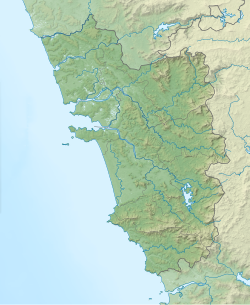
Francis Xavier, SJ, venerated as Saint Francis Xavier, was a Basque cleric. He was a Catholic missionary and saint who co-founded the Society of Jesus and, as a representative of the Portuguese Empire, led the first Christian mission to Japan.
Old Goa is a historical site and city situated on the southern banks of the River Mandovi, within the Tiswadi taluka (Ilhas) of North Goa district, in the Indian state of Goa.
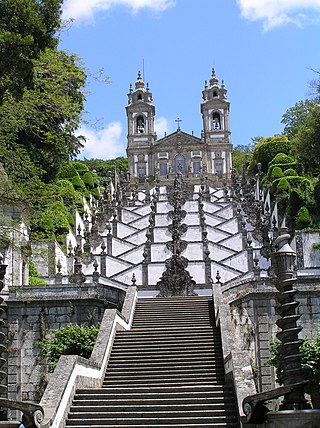
The Sanctuary of Bom Jesus do Monte is a Portuguese Catholic shrine in Tenões, outside the city of Braga, in northern Portugal. Its name means Good Jesus of the Mount.

The Church of the Gesù is the mother church of the Society of Jesus (Jesuits), a Catholic religious order. Officially named Chiesa del Santissimo Nome di Gesù, its façade is "the first truly baroque façade", introducing the baroque style into architecture. The church served as a model for innumerable Jesuit churches all over the world, especially in Central Europe and in Portuguese colonies. Its paintings in the nave, crossing, and side chapels became models for art in Jesuit churches throughout Italy and Europe, as well as those of other orders. The Church of the Gesù is located at the Piazza del Gesù in Rome, and is one of the great 17th century preaching churches built by Counter-Reformation orders like the Jesuits in the Centro Storico.

The Basilica of Bom Jesus is a Catholic basilica located in Goa, in the Konkan region of India. The iconic church is a pilgrimage centre and recognised by UNESCO as a World Heritage Site. The basilica is located in Old Goa, the former capital of Portuguese India, and holds the mortal remains of St Francis Xavier.
Goa is a state of India. Goans are commonly said to be born with music and football in their blood because both are deeply entrenched in Goan culture.

Coimbra New Cathedral, or the Cathedral of the Holy Name of Jesus, is currently bishopric co-seat (along with Coimbra Old Cathedral of the city of Coimbra, in Portugal. The cathedral is located near the historical University of Coimbra in the upper part of the town.

The Monastery of Jesus is a historical religious building in Setúbal, Portugal, which served a monastery of Poor Clare nuns. It is one of the first buildings in the Manueline style, the Portuguese version of late Gothic. The cloisters of the complex houses a museum of the monastery. In 2013, pan-European heritage organization Europa Nostra declared the monastery to be one of the 7 most endangered monuments in Europe.
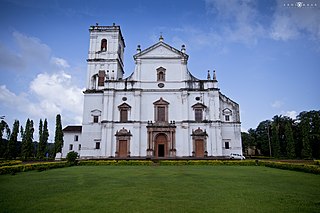
The Sé Catedral de Santa Catarina, known as Se Cathedral, is the cathedral of the Latin Church Archdiocese of Goa and Daman and the seat of the Patriarch of the East Indies. It is part of the World Heritage Site, Churches and convents of Goa located in Old Goa, India.
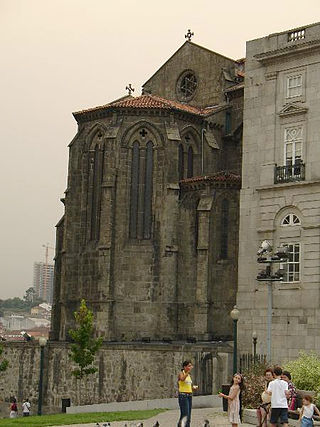
The Church of Saint Francis is the most prominent Gothic monument in Porto, Portugal, being also noted for its outstanding Baroque inner decoration. It is located in the historic centre of the city, declared World Heritage Site by UNESCO.

Portuguese architecture refers to both the architecture of Portugal's modern-day territory in Continental Portugal, the Azores and Madeira, as well as the architectural heritage/patrimony of Portuguese architects and styles throughout the world, particularly in countries formerly part of the Portuguese Empire.

The Cathedral Basilica of Salvador, officially dedicated to the Transfiguration of Christ and named Primatial Cathedral Basilica of the Transfiguration of the Lord is the seat of the Archbishop of the city of Salvador, in the State of Bahia, in Brazil. The Archbishop of Salvador is also ex officioPrimate of Brazil. The structure was built by the Society of Jesus as part of a large Jesuit monastic and educational complex. The current church is the built on the site, and was consecrated in 1654. After the expulsion of the Jesuits from Brazil in 1759 the school and church were transferred to the Archbishopric of Bahia. Archbishop Augusto Álvaro da Silva ordered the demolition of the existing cathedral of Salvador in 1933 to construct a tram line, and elevated the existing Jesuit structure to the status of basilica.
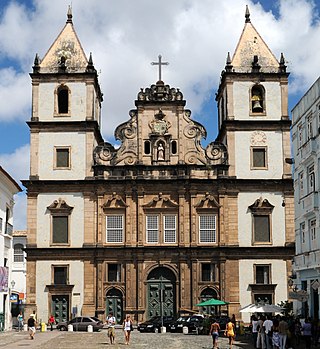
The São Francisco Church and Convent of Salvador is located in the historical centre of Salvador, in the State of Bahia, Brazil. The ornate Church of the Third Order of Saint Francis sits adjacent to the convent. The friars of the Franciscan Order arrived in Salvador in 1587 and constructed a convent and church on the site. This structure was destroyed by the Dutch during the Dutch invasions of Bahia in the next century; Father Vicente das Chagas initiated the current structure in 1686, which was completed in the 18th century. The Franciscan church and convent have the largest number of azulejos, 55,000, of any church in Latin America.

The Roman Catholic Metropolitan Archdiocese of Goa and Daman encompasses the Goa state and the Damaon territory in the Konkan region, by the west coast of India. The ecclesiastical province of Goa and Damaon includes a suffragan diocese, the Sindhudurg Diocese that comprises the Malvani areas of. The Archbishop of Goa also holds the titles of Primate of the East and Patriarch of the East Indies, also hold the title of the Syrian Catholic Primate of the Archdiocese of Cranganore. The beginnings lie in the Padroado system of Portuguese Goa and Damaon, in the early 1900s the primatial see was transferred back to the Sacred Congregation for the Evangelisation of Peoples, as the Padroado system of the Indo-Portuguese era was being dismantled.
The architecture of Goan Catholics has strong Portuguese and native Goan influences. It developed over the Portuguese India era (1500s–1961).

The Church of St. Francis of Assisi was built in 1661 by the Portuguese in the Portuguese Viceroyalty of India. The Church of St. Francis of Assisi, together with a convent, was established by eight Portuguese Franciscan friars who landed in Goa in 1517. It is part of the UNESCO World Heritage Site, Churches and convents of Goa.

The St. Paul’s Church and officially College of the Holy Spirit and Church of Our Lady of the Conception or Saint Paul, is situated on Diu Island, on the west coast of India, a Union Territory of India. Diu came under the control of Portuguese colonists in early 16th century.

The Christian population of Goa are almost entirely Goan Catholics, whose ancestors converted to Christianity during the Portuguese rule in India. Christianisation followed the Portuguese conquest of Goa in 1510, which was followed by the Goa Inquisition from 1560 onwards. The Hindu population is mostly descended from immigrants from other states of India, who have been arriving in Goa since the last century There is a higher proportion of Christians in Velhas Conquistas than in Novas Conquistas.

The Church of Our Lady of the Rosary is a Catholic church built between 1544 and 1547, in Old Goa, State of Goa, India. This church is part of the collection belonging to the World Heritage Site of churches and convents of Goa.

The Chapel of St. Catherine is a UNESCO World Heritage Site located in Old Goa in the same compound as Se Cathedral and the Church and Convent of St. Francis of Assisi. It was built in 1510 in the Baroque architectural style, and has a brown and white facade. It faces the Mandovi River and is part of the World Heritage Site, Churches and convents of Goa. The chapel is not functional.

